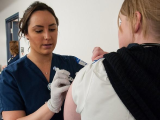A randomized clinical trial shows no overall increase in end-of-season influenza vaccination rates after patients viewed physician-created video messages or an infographic containing the physician's photo—although both interventions boosted vaccination rates among children.
University of California Los Angeles (UCLA) researchers led the study of 22,233 UCLA Health patients who didn't receive the flu vaccine between October 2023 and April 2024 and their 21 primary care physicians.
The study findings were published yesterday in JAMA Network Open.
Declining vaccination rates, skeptical patients
Patients were randomly assigned to receive usual care, a physician-created smartphone video, or an infographic with their physician’s photo up to three times (October, November, and December) through the patient portal. Both interventions used similar scripts encouraging patients to get vaccinated against flu.
While most people trust their physicians overall, many don't feel that the benefits of an influenza vaccine outweigh its safety and believe that they are not at risk from influenza disease.
Of the 22,233 patients, 14.4% were children, 66.1% were aged 18 to 64 years, 19.5% were 65 and older, 62.8% were female, and 84.9% had private health insurance. Portal messages for pediatric practices were addressed to the child's parent, but those for adolescents older than 12 years with portal privileges were addressed to them.
A US Healthy People 2030 goal is to reach 70% vaccine uptake, but the authors note that vaccination rates have plateaued since 2010 and declined since 2020. For the 2023-24 flu season, coverage was 55.4% for children aged 6 months to 17 years, 32.8% for adults aged 18 to 49 years, 46.2% for those 50 to 64, and 69.7% for those 65 years and older.
"A major cause of low influenza vaccination is patient vaccine hesitancy," they noted. "While most people trust their physicians overall, many don't feel that the benefits of an influenza vaccine outweigh its safety and believe that they are not at risk from influenza disease."
No increase in vaccination over usual care in adults
Overall flu vaccination rates by April 2024 were 46.9% for usual care, 48.0% for video recipients, and 47.5% for infographic recipients. Neither intervention had significantly higher vaccination rates than usual care (adjusted risk ratio, 1.03 for the video and 1.02 for the infographic).
But a prespecified secondary analysis showed that children in both intervention arms had slightly higher vaccination rates by April 2024: 58.4% in the video group and 55.1% in the infographic group, compared with 54.5% in the usual-care group. The number needed to treat to achieve one additional flu vaccination among children was 26 in the video group and 167 in the infographic group.
Findings from this study indicate that health systems should consider physician-created video messages to increase child influenza vaccination rates and that further investigation of innovations for improving influenza vaccination rates across the entire population is warranted.
Of 18 physicians who responded to a survey after intervention implementation, most said it was easy to record the video and that they would be willing to do so for other preventive services. While most said they felt confident or neutral about recording the video, many would request technical support.
A post hoc analysis showed that both interventions improved timely vaccination by December 31 by a small amount overall and a moderate amount for children. "These interventions may be considered important because influenza often peaks in December or January in the US, and there is a lag of about 2 weeks between vaccination and immunity," the researchers wrote. "Thus, vaccination by end of December is preferred."
"Findings from this study indicate that health systems should consider physician-created video messages to increase child influenza vaccination rates and that further investigation of innovations for improving influenza vaccination rates across the entire population is warranted," they added.



















